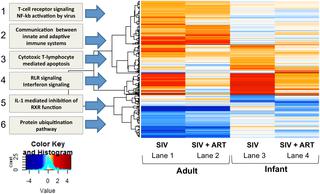当前位置:
X-MOL 学术
›
PLOS Pathog.
›
论文详情
Our official English website, www.x-mol.net, welcomes your
feedback! (Note: you will need to create a separate account there.)
Liver macrophage-associated inflammation correlates with SIV burden and is substantially reduced following cART.
PLoS Pathogens ( IF 5.5 ) Pub Date : 2018-02-21 , DOI: 10.1371/journal.ppat.1006871 Bridget S Fisher 1 , Richard R Green 2 , Rachel R Brown 1 , Matthew P Wood 1 , Tiffany Hensley-McBain 3 , Cole Fisher 1 , Jean Chang 2 , Andrew D Miller 4 , William J Bosche 5 , Jeffrey D Lifson 5 , Maud Mavigner 6 , Charlene J Miller 3 , Michael Gale 2 , Guido Silvestri 6, 7 , Ann Chahroudi 7, 8 , Nichole R Klatt 3 , Donald L Sodora 1
PLoS Pathogens ( IF 5.5 ) Pub Date : 2018-02-21 , DOI: 10.1371/journal.ppat.1006871 Bridget S Fisher 1 , Richard R Green 2 , Rachel R Brown 1 , Matthew P Wood 1 , Tiffany Hensley-McBain 3 , Cole Fisher 1 , Jean Chang 2 , Andrew D Miller 4 , William J Bosche 5 , Jeffrey D Lifson 5 , Maud Mavigner 6 , Charlene J Miller 3 , Michael Gale 2 , Guido Silvestri 6, 7 , Ann Chahroudi 7, 8 , Nichole R Klatt 3 , Donald L Sodora 1
Affiliation

|
Liver disease is a leading contributor to morbidity and mortality during HIV infection, despite the use of combination antiretroviral therapy (cART). The precise mechanisms of liver disease during HIV infection are poorly understood partially due to the difficulty in obtaining human liver samples as well as the presence of confounding factors (e.g. hepatitis co-infection, alcohol use). Utilizing the simian immunodeficiency virus (SIV) macaque model, a controlled study was conducted to evaluate the factors associated with liver inflammation and the impact of cART. We observed an increase in hepatic macrophages during untreated SIV infection that was associated with a number of inflammatory and fibrosis mediators (TNFα, CCL3, TGFβ). Moreover, an upregulation in the macrophage chemoattractant factor CCL2 was detected in the livers of SIV-infected macaques that coincided with an increase in the number of activated CD16+ monocyte/macrophages and T cells expressing the cognate receptor CCR2. Expression of Mac387 on monocyte/macrophages further indicated that these cells recently migrated to the liver. The hepatic macrophage and T cell levels strongly correlated with liver SIV DNA levels, and were not associated with the levels of 16S bacterial DNA. Utilizing in situ hybridization, SIV-infected cells were found primarily within portal triads, and were identified as T cells. Microarray analysis identified a strong antiviral transcriptomic signature in the liver during SIV infection. In contrast, macaques treated with cART exhibited lower levels of liver macrophages and had a substantial, but not complete, reduction in their inflammatory profile. In addition, residual SIV DNA and bacteria 16S DNA were detected in the livers during cART, implicating the liver as a site on-going immune activation during antiretroviral therapy. These findings provide mechanistic insights regarding how SIV infection promotes liver inflammation through macrophage recruitment, with implications for in HIV-infected individuals.
中文翻译:

肝脏巨噬细胞相关炎症与 SIV 负荷相关,并且在 cART 后显着减少。
尽管使用了联合抗逆转录病毒疗法(cART),但肝病仍然是 HIV 感染期间发病率和死亡率的主要原因。 HIV感染期间肝病的确切机制人们知之甚少,部分原因是难以获取人类肝脏样本以及存在混杂因素(例如肝炎合并感染、饮酒)。利用猿猴免疫缺陷病毒(SIV)猕猴模型,进行了一项对照研究,以评估与肝脏炎症相关的因素以及 cART 的影响。我们观察到未经治疗的 SIV 感染期间肝巨噬细胞增加,这与许多炎症和纤维化介质(TNFα、CCL3、TGFβ)相关。此外,在感染SIV的猕猴的肝脏中检测到巨噬细胞趋化因子CCL2的上调,这与表达同源受体CCR2的活化CD16+单核细胞/巨噬细胞和T细胞数量的增加同时发生。 Mac387 在单核细胞/巨噬细胞上的表达进一步表明这些细胞最近迁移到肝脏。肝巨噬细胞和T细胞水平与肝SIV DNA水平密切相关,与16S细菌DNA水平无关。利用原位杂交,SIV 感染的细胞主要在门脉三联体中发现,并被鉴定为 T 细胞。微阵列分析发现,SIV 感染期间肝脏中存在强烈的抗病毒转录组特征。相比之下,接受 cART 治疗的猕猴表现出较低水平的肝脏巨噬细胞,并且炎症状况显着但不完全减少。 此外,在 cART 期间在肝脏中检测到残留的 SIV DNA 和细菌 16S DNA,这表明肝脏是抗逆转录病毒治疗期间持续免疫激活的部位。这些发现提供了有关 SIV 感染如何通过巨噬细胞募集促进肝脏炎症的机制见解,对 HIV 感染者具有影响。
更新日期:2018-02-22
中文翻译:

肝脏巨噬细胞相关炎症与 SIV 负荷相关,并且在 cART 后显着减少。
尽管使用了联合抗逆转录病毒疗法(cART),但肝病仍然是 HIV 感染期间发病率和死亡率的主要原因。 HIV感染期间肝病的确切机制人们知之甚少,部分原因是难以获取人类肝脏样本以及存在混杂因素(例如肝炎合并感染、饮酒)。利用猿猴免疫缺陷病毒(SIV)猕猴模型,进行了一项对照研究,以评估与肝脏炎症相关的因素以及 cART 的影响。我们观察到未经治疗的 SIV 感染期间肝巨噬细胞增加,这与许多炎症和纤维化介质(TNFα、CCL3、TGFβ)相关。此外,在感染SIV的猕猴的肝脏中检测到巨噬细胞趋化因子CCL2的上调,这与表达同源受体CCR2的活化CD16+单核细胞/巨噬细胞和T细胞数量的增加同时发生。 Mac387 在单核细胞/巨噬细胞上的表达进一步表明这些细胞最近迁移到肝脏。肝巨噬细胞和T细胞水平与肝SIV DNA水平密切相关,与16S细菌DNA水平无关。利用原位杂交,SIV 感染的细胞主要在门脉三联体中发现,并被鉴定为 T 细胞。微阵列分析发现,SIV 感染期间肝脏中存在强烈的抗病毒转录组特征。相比之下,接受 cART 治疗的猕猴表现出较低水平的肝脏巨噬细胞,并且炎症状况显着但不完全减少。 此外,在 cART 期间在肝脏中检测到残留的 SIV DNA 和细菌 16S DNA,这表明肝脏是抗逆转录病毒治疗期间持续免疫激活的部位。这些发现提供了有关 SIV 感染如何通过巨噬细胞募集促进肝脏炎症的机制见解,对 HIV 感染者具有影响。











































 京公网安备 11010802027423号
京公网安备 11010802027423号